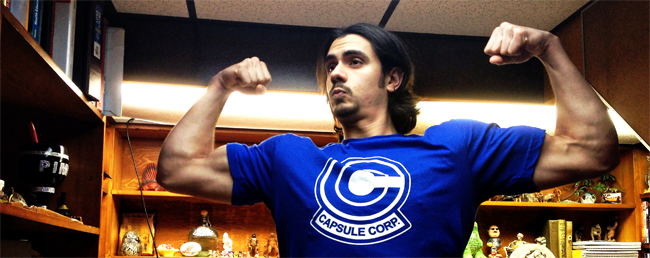Public gyms are bio-social Petri dishes. A bunch of people pretending they aren’t looking at (and mutely judging) everyone else. A bunch of people pretending to exist in their own bubble, earbuds blaring, yet somehow also respecting social norms. With my penchant for people watching and my fondness for flânerie, you’d think public gyms would [...]
Public gyms are bio-social Petri dishes. A bunch of people pretending they aren’t looking at (and mutely judging) everyone else. A bunch of people pretending to exist in their own bubble, earbuds blaring, yet somehow also respecting social norms.
With my penchant for people watching and my fondness for flânerie, you’d think public gyms would be my version of a crack house. But I hate them.
No, I don’t want my body to be lathered in the foul fungal sweat that’s caked into the bench you were just using. No, I don’t want to ask you if you’re still using the squat rack (for curls). No, I’m not looking at the hot girl on the adductor machine.
Public gyms: be judged as you attempt to look like you know what you’re doing…for a small monthly fee.
Being able to train alone in my garage fits my recluse personality; my garage gym is a huge reason for my success.
I only own what I need, so my attention isn’t torn between dozens of toys. I can take my time. I can be free with my own thoughts, which won’t include dreams about committing adultery with the hot girl on the adductor machine that I’m definitely not looking at.
I can fart. Anytime I want. I can just fart. And I do. Ah, the sound of freedom is sweet. The scent? Well, no so much.
But isn’t the equipment expensive? Not really. I bought most of what I (now) own as a college kid working part time.
Doesn’t it take up a lot of room? Not really. I fit most of what I (now) own in the back of my parent’s one car garage (and they were still able to park the car in the garage).
Can you tell me what to buy? I thought you’d never ask. Just kidding. I knew you’d ask because I’m the one asking myself as if I were you. And if I were you then you’d be me, and I’d use your body to climb this cliff.

Below is a list of equipment I recommend. It’s ordered by importance but, at the same time, it’s not. Because “importance” is contextual.
For instance, I recommend (below) buying a squat rack before you buy pull-up bar. But I value the pull-up bar more than the squat rack. Why the backwards recommendation, then? Because a lot of squat racks can be pull-up bars!
So if you’re really thinking about building a garage gym, don’t take the headlines below at face value. Read the writing below the headlines. I know, I know. You’re not used to doing that, but, if you plan on reading my writing, you should get into the habit.
And look for the blue boxes. I’ll tell you what exercises you can do with the equipment. Because I’m nice. Or something.
If you have the space, the cash, and are looking for a simple list of commands without all of the details click here.
#1, Olympic barbell(s)
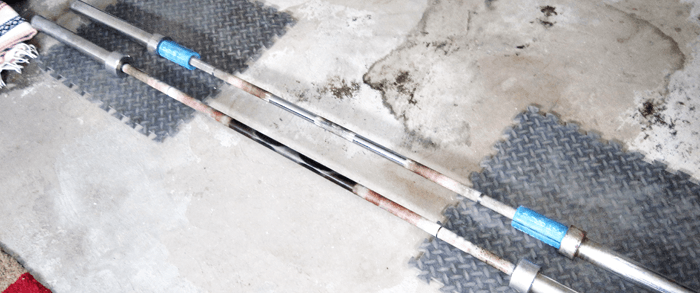
Choosing a bar is like choosing a wedding ring. Don’t spend more than you can afford; don’t cheap out. If you don’t have enough money to buy something nice, save up until you do.
You’re going to load this sucker with hundreds of pounds. You don’t want it to snap in half above your throat when you’re doing bench presses, do you?
Buy an OLYMPIC bar. They are 7 feet long and weigh 45 pounds. There are smaller bars out there called “standard” bars.
Standard bars are infinitely cheaper and infinitely more useless. They’re fine if you’re just getting started, or if you aren’t yet strong enough to move a lot of weight. But you’ll outgrow them. Quickly.
An Olympic bar is a long term investment. They aren’t cheap. But spending some extra money is better than having metal shards fly in your face mid-rep if (when) your cheap bar breaks.
I have two bars. One is a higher quality bar that I bought from Glenn Pendlay’s website years ago. The other came with some weights I bought at a local department store.
You can find some cheap(er) bars on Amazon, like this one or this one. But, like I said, trust is important. You’re (probably) not going to have to buy more than one of these in your lifetime, so think about splurging.
I do all of my heavy lifting on bar I bought from Glenn Pendlay. I don’t trust the cheaper department store one. The specific bar I bought from Glenn Pendlay no longer exists. The B&R Bar is similar to the one I have, only better. It was designed for general strength training purposes. Rogue is a good brand.
I’m also a fan of Fringe Sport, as I’ve personally met one of head honchos over there. Check out the Wonder Bar and the Bomba Bar.
Olympic barbells versus Olympic weightlifting barbells
The barbells linked to above are Olympic barbells, but they aren’t Olympic weightlifting barbells. Olympic weightlifting barbells are built with more whip and spin (jargon you don’t have to worry about) to handle a bunch of cleaning and snatching.
Olympic weightlifting barbells are more expensive. If you don’t plan on doing serious Olympic weightlifting, you just need a general purpose bar, like the ones linked above.
One Olympic barbell is a must. Two Olympic barbells is a luxury worth considering. With two bars, you can superset exercises. You don’t have to constantly move the bar between the floor and the rack (if you have a rack). Life is easier with two, but one will do.
#2, Olympic sized plates
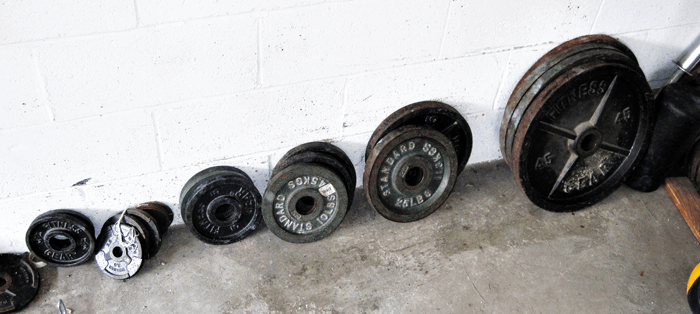
I have two sets of Olympic sized plates. The first I bought at a local sporting goods store. The second I bought on Craigslist.
Craigslist is the way to go when it comes to plates. I got 500 pounds for around $80. The diameter of the plates will differ by a few centimeters (if you’re mixing and matching brands), which can get annoying when loading and unloading the bar, but it’s a small price to pay. I’m frugal. Oh well.
A hunk of iron is a hunk of iron, unless we’re talking about hex plates. Avoid hex plates. They make pulling from the floor a pain.
In general, the 35 pound plates are useless. I’ve never ran into problems with the following plate breakdown.
- Enough 45 plates to suit your strength level
- Four 25 pound plates
- Six 10 pound plates
- Eight 5 pound plates
- Four 2.5 pound plates
If you only have one bar, then you can probably half the 5 and 2.5 pound plate recommendations; buy four 5 pound plates and two 2.5 pound plates.
#3, Fractional plates
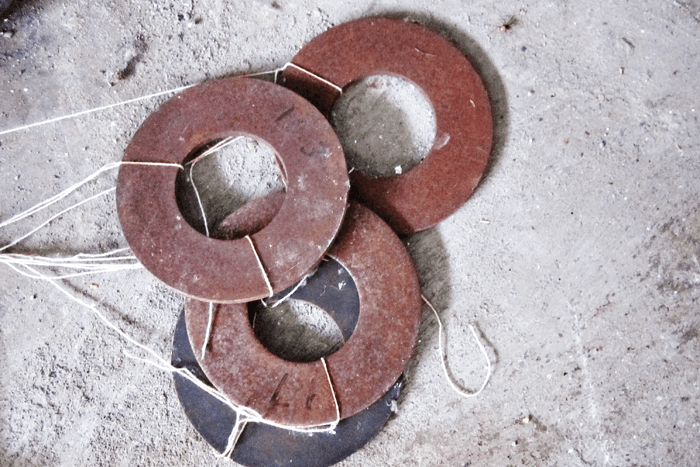
I’m a huge fan of micro-loading (read: adding one pound to the bar every training session). The lightest plate in (most) domestic weight sets is 2.5 pounds. So the lowest increment of weight you can add to the bar is 5 pounds. Which sucks.
What if you wanted to add one, two, three, or four pounds? You’re screwed. Unless you have fractional plates.
A lot of fractional plate sets are expensive, but they don’t have to be. This set by Iron Bull is good. I have them. I use them almost every time I train.
You can also buy two inch plumbing washers. Click here to see the ones I have. Each one weighs about 10 or 11 ounces, so two combined are a hair over one pound. But, uhh, just buy the Iron Bull plate set. They’re cheap. They work.
Program Potential
↓
With a barbell and plates, you can do:
- Deadlifts of all sorts
- Power cleans
- Power snatches
- Overhead presses
- Barbell rows
- Barbell curls
And that’s just the beginning. There are many more exercises you can do, including bodyweight exercises like:
- Bodyweight squat variations
- Push-up variations
Already a good program is forming.
You can do deadlifts for strength, and then pursue different bodyweight squat variations, like pistol squats and cossack squats.
You can do overhead presses for strength, and then pursue different push-up variations, like one-arm push-ups and planches.
You can do barbell rows for strength, and then pursue different curl variations for further arm stimulation.
#4, Uprights
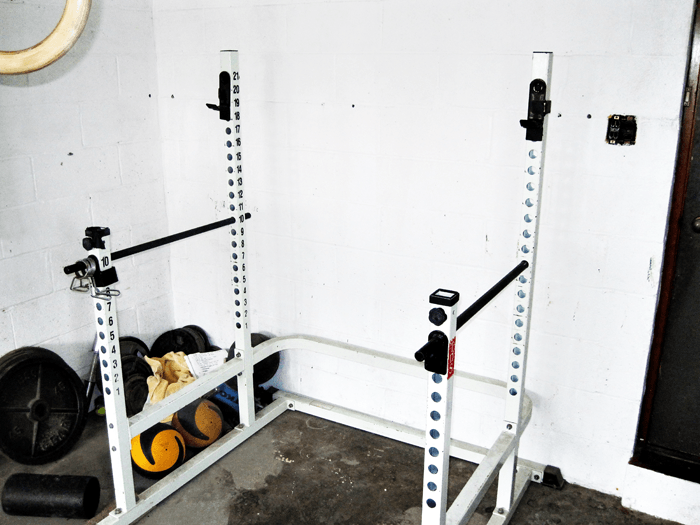
I used a cheap squat stand for a long time. (A squat stand is just a pair of uprights.) But it wasn’t the safest thing to do. Before I tell you why, let me tell you about the best upright system: a full power rack.
A full power rack is square cage of metal. It offers a few benefits that a squat stand doesn’t.
First, when you’re racking the bar inside of a power rack, you’re guided by the uprights. When you’re using a squat stand, you have to precisely set the bar back onto the hooks.
Second, power racks are sturdier. If you intend on getting stronger, this is important.
Third, power racks have safety pins. If you know how to use safety pins correctly, you’ll never need a spotter. There is a way to adjust the pins to always prevent the bar from crashing on them before you. This is crucial if you’re training alone at home.
If you don’t have safety pins, hmmm. If you’re benching and the bar slips out of your hands, it’ll crash onto your throat. If you’re squatting and you can’t finish a repetition, you have to ditch the bar behind you and create two craters in your floor.
(Funny story: About four years ago, I put a huge hole in my parents back porch because I lost a snatch behind me. Oops.)
Fourth, power racks have multiple uses. They usually have a pull-up bar built into the top, and some have a dip attachment you can buy.
So power racks are useful and without a doubt the best upright system option. But they are big. So, if space is a concern, you should look into a GOOD squat stand, which is to say: a squat stand with safeties. Or some kind of short power rack.
#5, Chin and dip station
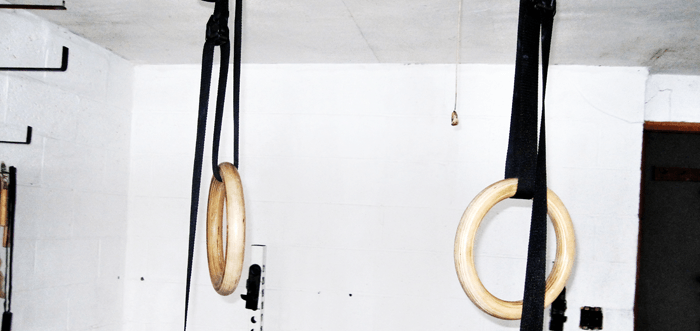
Gymnastics rings are, without a doubt, the BEST piece of equipment to have after a barbell. If you have a heavy barbell and some gymnastics rings, you don’t really need anything else.
There’s a good chance that, sometime in the future, I’m going to get rid of everything I own except these two things.
My friends over at Gold Medal Bodies recommended Rogue’s wooden rings. I have these. I lof these. (If you plan on using them outside, don’t get a wooden pair.)
But not everyone is ready to hop on gymnastics rings. You need to train on a stable surface before you move to an unstable surface. The stable version of gymnastics rings is a power tower.
A power tower lets you to do chin-ups and dips, but I don’t recommend getting a power tower. You can be creative.
A lot of power racks (and good squat stands) have pull-up bars built in at the top. Some even have dip bar attachments, like this.
If you have the space and the money, this is WITHOUT A DOUBT the way to go. Buy a good power rack that can also be used as a chin-up and dip station.
Alsa, if you have a power rack and two bars, you have a shady but operable chin and dip station.
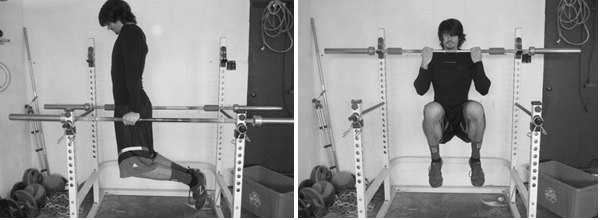
For chin-up, put the J hooks to the highest setting. Put the barbell in the hooks and throw a 45 or two on each side for security. Grab the barbell, tuck the knees to the chest, and you’re on your way to chins. (The only downside to this is that you can’t really do weighted chins.)
For dips, put the safety pins at a decent enough height so that your legs don’t hit the ground on the descent. Throw both of your barbells on top of the pins, slide them to the outside as far as they go, and then slide them back (or forward) so they “lock” in place. If you don’t do this, they’ll slide.
But, keep in mind: if your rack is too wide, then you won’t be able to do dips. The bars will be too far apart.
Program Potential
↓
With gymnastics rings (which are essentially a chin-up bar and dip station in one) you’re open to an entire world of exercises.
Let’s first assume no rings, and just a chin-up bar. You can work on chin-ups and pull-ups and their variations, like one-arm chin-ups and such. An added dip station allows you to do dips. Each lets you do hanging knee and leg raises.
If you add gymnastics rings, you have the ability to lower and raise the rings. You can do ring rows and ring push-up variations, which are challenging enough for most people to do for a long time.
#6, Incline capable bench
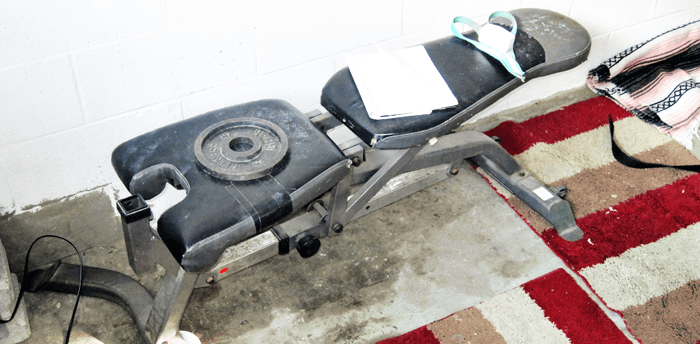
I’m a big fan of the incline press over the flat bench press (because), so it should be no surprise that I prefer a bench with the potential to incline to 30-degrees.
I found mine at a local sporting goods store for around $100. It’s not professional grade, but it works. If you’re a strong bencher, perhaps you should consider something sturdier.
The adjustable bench selection online isn’t that great. Here’s one on Amazon that looks decent enough. I mean…it’s Bowflex. So. Uhhh. Whatever.
If possible, buy a bench without the leg curl and leg extension attachment. The extra junk added to the bench to enable these exercises will just get in the way.
#7, Dip belt and chain

I don’t know why weight belts are often called “dip” belts, but they are. Dip belts (or whatever you want to call them) allow you to attach weight around your waist for exercises like chin-ups and dips.
Funnily enough, I use a tree climbing belt. It’s 0% comfortable, but it was a (free) gift from a friend. There are much friendlier options out there.
As for the chain, just go to any local hardware store and get one that supports a decent amount of weight.
#8, Collars
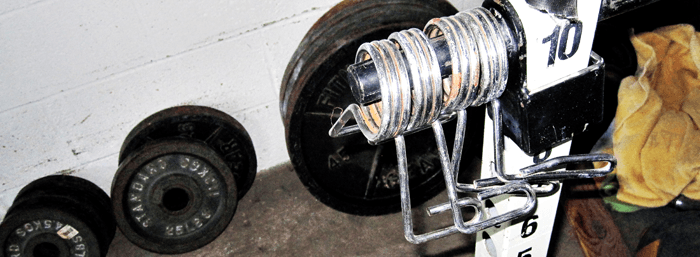
Rather bland and not very eye catchy, collars are necessary at times. You don’t want plates to scatter from the bar as you attempt a maximal squat, so they’re worth the investment. Again, a back injury isn’t worth cheaping out on $20.
Collars come in many shapes, but I suggest avoiding being cheap here. Cheap collars get bent out of shape easily, which then are a pain to put on and take off. You squeeze with all your might to no avail.
This isn’t to say you have to go pro-grade and spend a billion dollars, but don’t go for a $2 pair.
#9, A notebook (or two)
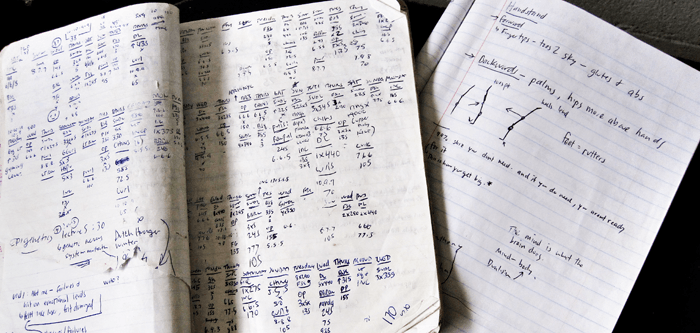
Please allow a moment of reflection, as my first training journal — the same companion that has logged every one of my training sessions since 2007! — has since run out of pages. It’s a sad day when this happens, but it’s the natural course of life.
With that, don’t be anal with your training journal. I suggest immediately throwing it against the wall, bending it and half, and curling the corners. This guy will be around for a long time, and it won’t stay pristine. Might as well introduce it to reality sooner rather than later.
You also might want to have two notebooks. One to track the hard facts, and another to jot down some notes on a particular lift of maneuver. If you don’t, it’s easy for the tips to get lost at sea.
#10, Magnesium carbonate
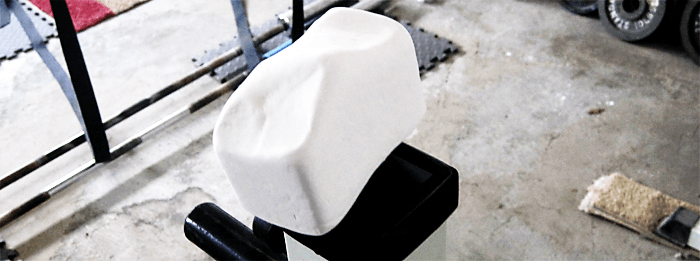
Magnesium carbonate goes by the street drug dealing name of “chalk.”
You need chalk.
Go watch the Olympics. Olympic weightlifters bathe in chalk before they lift. Gymnasts bathe in chalk before their routine.
You need to bathe.
But a box of chalk blocks. That’s all. Don’t worry about a grandiose chalk stand. Just take the bars and rub them over your hands.
The purpose of chalk, if you’re wondering, is to dry out your hands. This isn’t like steroids or anything. You’re simply revealing your true grip potential, sans sweat and other air factors. And since we grip things a lot, this is important.
The link above is a link for eight blocks. I bought eight blocks about five years ago. I still have five unopened. And I think I even gave half a block away. This stuff will last you a long time.
#11, Good shoes
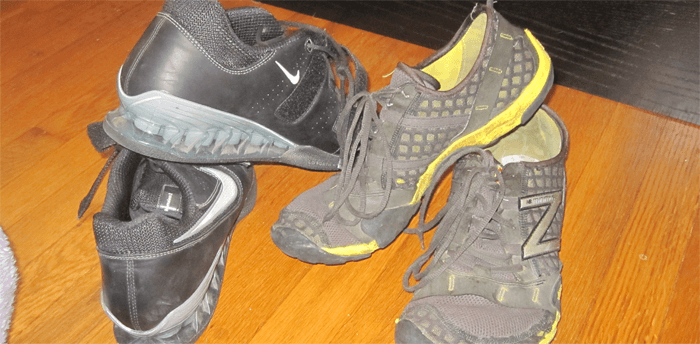
Hi ho silver, I could talk about shoes forever.
The type of shoe you need depends on what you plan on doing. In general, if you aren’t a professional powerlifer or Olympic weightlifter, you simply want to look for a shoe with minimal bottom cushioning and a flat sole.
The classic example here is that of a bed mattress. The more padding you have on the bottom of your shoe, the more unstable you are. Being unstable with hundreds of pounds loaded on your spine sounds as safe as a game of Russian roulette.
Chuck Taylors are a common cheap option. I have the first generation New Balance Minimus Trail shoe, and I love it.
I link to Amazon here and not New Balance for a couple of reasons. First, the shoe I have is no longer sold by New Balance. Second, New Balance now makes a bunch of Minimus shoes. Going by number, if you want a pair like mine, look for anything with the number 10 in the name. I think?
Some people opt to lift in very minimal footwear, like Vibram Five Fingers, but I’ve since opted out of that after breaking my foot. I don’t care about barefoot benefits when a fluke accident with a 2.5 pound plate can easily cause broken toes, and when a 5 pound plate can easily cause broken feetsies. Want barefoot benefits? Go out in grass and frolic around. Trick.
If you’re of a more serious mindset, you can buy Olympic weightlifting shoes.
I have a pair of the Nike Romaleos II, but they don’t agree well with my foot neuroma. They’re solid though, and I recommend them.
All in all, footwear is a rabbit hole. Many different brands, many different options, and I’m only one rather frugal dude. Just know that you don’t want to be wearing most marshmallowy soled tennis shoes.
#12, Radio
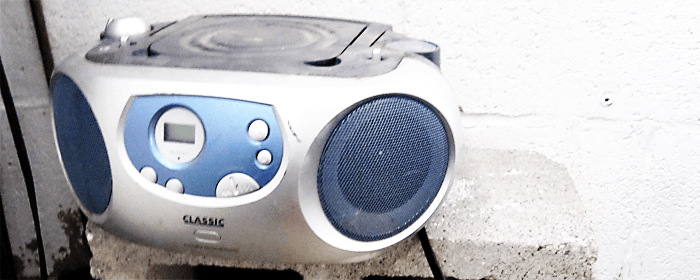
Jam away. I highly recommend getting an AUX cable, too. That way, you can listen to anything that’s on your phone, including lectures or audio books. Also, look online (not in store) for an AUX cable. I got mine off Amazon for like $0.99. You just have to make sure whatever you have has AUX cable compatibility.
For some reason, my radios have a terribly short shelf life in my garage. (Maybe two or three years, I think? Maybe less? And this is in regards to CD function, by the way.) It might be because of the weather conditions, getting both cold in the winter and hot in the summer, or because there’s probably chalk dust all over its innards. Whatever. Don’t break the bank. Just get something that works good enough.
#13, Puzzle mats and old rugs
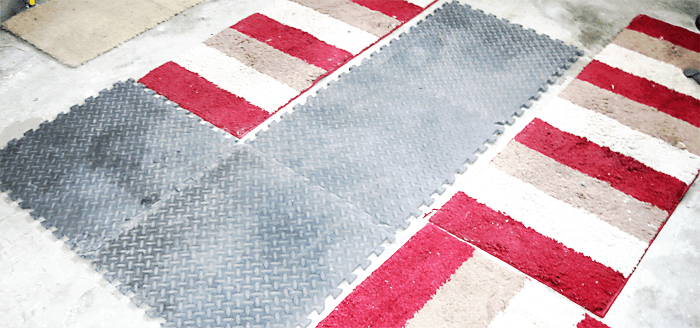
True story: before my parents throw away any rugs, they ask me if I want them.
Mats or rugs aren’t necessary, but they’re extremely useful — certainly nice to line the floor with for a cushioned surface (don’t lift on puzzle mats though, stand on a hard surface; see shoe section).
Also you can put puzzle mats under each end of the barbell to give your garage floor some protection when doing deadlifts.
Half of my garage is a gymnastics space where I do rolls, handstands, and other like movements. That half is lined with these puzzle mats and rugs, and trust me: it helps. Even though the rugs are undoubtedly dirty, it beats the cold floor.
#14, Parallettes
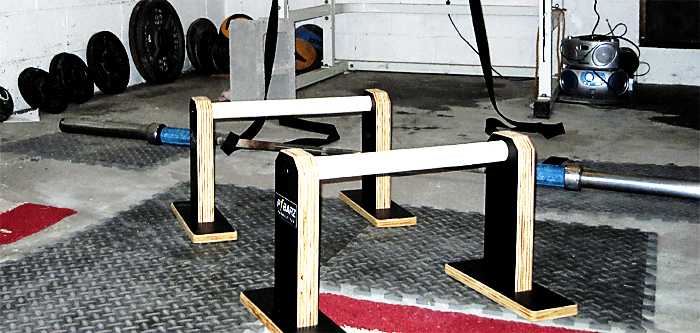
When I’m flailing around miserably with the gymnastics flu (and failing to keep locked out elbows), I’m glad I have my parallettes. Once again, I listened to Gold Medal Bodies and went with a wooden pair.
Useful for gymnastics exercises, elevated handstand or push-up shenanigans and that whole bag of tricks.
If you want to try to get this done on the cheap, you can opt for cinder blocks. I used them for a good while before switching over. The problem with cinder blocks is that they offer you little advantage in the wrist health department, which tends to be a big issue if you’re doing other gymnastics movements on flat ground.
Not only will you be useless if you have a wrist injury, but you’re also adding to the wrist stress you’re already exposing yourself too. I’m glad I don’t use the cinder blocks anymore, hah.
#15, Fat gripz
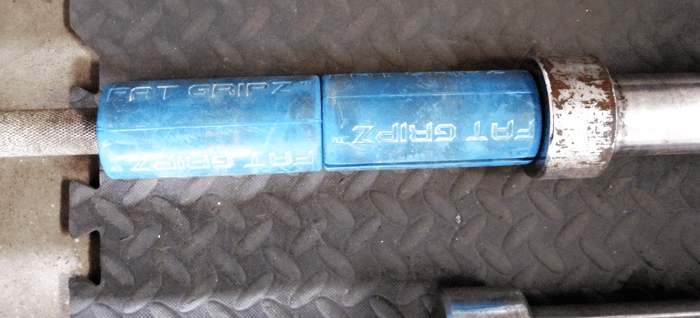
Back in the day (like six months ago), I used Fat Gripz for just about every upper body lift. Incline presses, overhead presses, and curls were my primary targets. Even to this day, if I ever do any of these exercises, I use them. If you barbell curl, you better be using them.
Might seem like a steep investment for some rubber, but there is good at work. With the thicker grip, you “complete the chain” as it makes you squeeze the bar harder — there’s a more solid connection between the your body and the bar.
This, crazily enough, tends to fix elbow and shoulder pain from pressing. In other words: seemingly expensive piece of rubber becomes an essential life saver.
You can also wrap towels around the bar if you want to go thick grip on the cheap. But . . . srlsy bro . . . ?
#16, Dr. Sapolsky
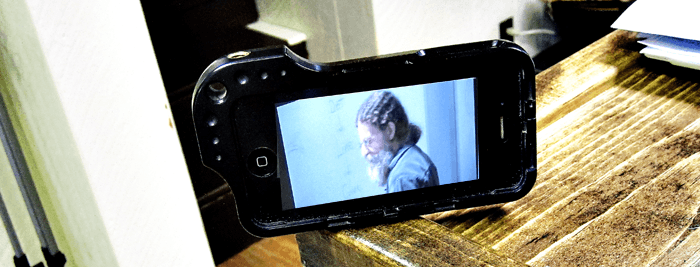
Yes. Buy Dr. Sapolsky. Kidnap him. Hrmmmmmmrmrmm!
#17, Kettlebells
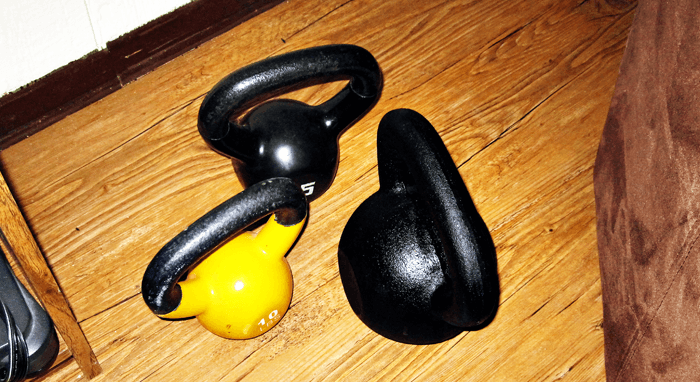
I personally don’t use kettlebells. That’s not to say I have anything against them, but it’s just another hunk of iron to consider. My gymnastics flu is severe enough to not pay them attention, whether that’s a good or bad thing — not so sure.
I buy kettlebells for my girlfriend. She usually pops, locks, and drops it here and there, and they are convenient enough for her to enjoy using them.
Now, kettlebells are usually expensive. Mondo expensive. But there’s a retailer on Amazon that sells them rather cheap.
Bought my girlfriend one and they seem alright. The catch, I think, is that the handle is slightly off center. If you’re a kettlebell zealot, I’m sure that matters. If you aren’t, I’m not sure it does.
Kettlebells are cool though. One of these days, I’m going to take them to a park and just throw them. I don’t know why, but it seems like fun.
#18, Space heater
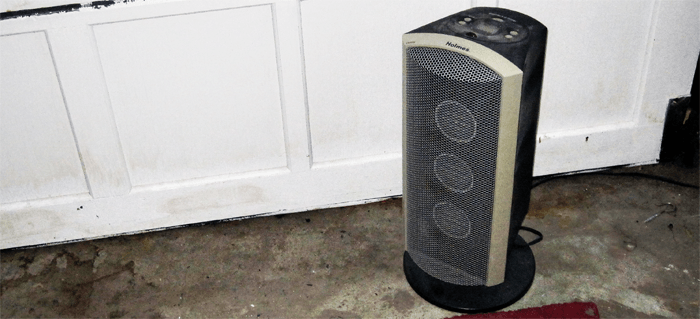
If you live in a place that gets cold, a space heater is a nice thing to have. Don’t come to me when the electric bill is high, but come to me whenever your hands thank you for grabbing only a freezing bar instead of a below freezing bar.
While were here, let’s talk cold gear.
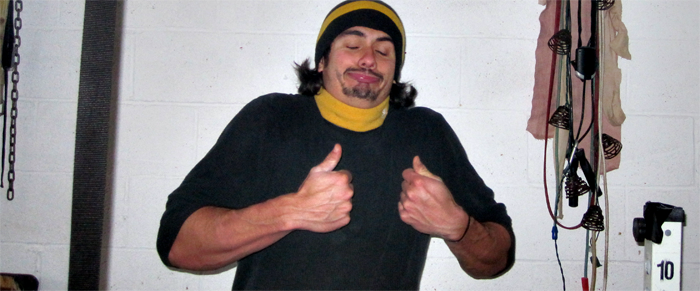
Wearing a hoodie is generally a no-no, as it makes squatting tough. The hood messes with me with handstands, too. I’ve found the best type of cold gear is a nice sweatshirt. Underneath, wear some long johns so that whenever your body temperature rises, you still have something warm on underneath when you take off the sweatshirt (if you decide to).
Since the head gets cold too, I like wearing a toque or beanie. Combined with that, I use those thick cloth headbands things, but I put them around my neck. It’s a nice little scarf contraption that doesn’t go anywhere.
#19, Bands
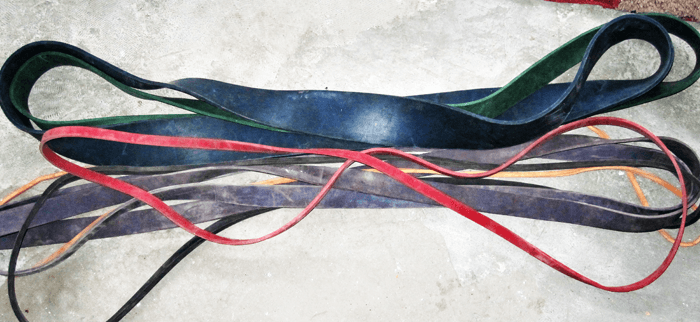
Bands come in handy at times. I stretch with them sometimes. I make my little cousin do endless repetitions of band pull aparts, too.
Whenever I’m doing weighted dips, the weight belt hits the floor. Instead, I’m an idiot and loop weights around the bad and then loop the band around my neck. It’s not a safe practice, but the only place the weight can go is down. Not bad considering I’m up.
Seriously though, get bands of varying strength. The colors are your guide there.
As for where to buy, they are available lots of places these days. Mine are from JumpStretch, but they are on EliteFTS as well as IronWoody.
#20, Straps
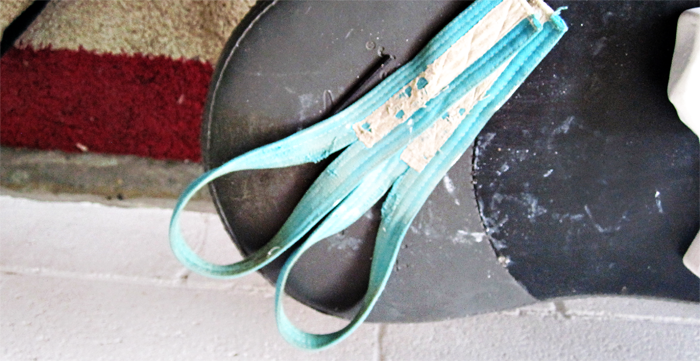
I’m of the opinion that everyone with a soul should snatch grip deadlift. I credit wide grip pulling for a lot of things, and that’s really not a possible long term feat without straps (unless you want your fingers to mangle into mush).
When moving into more advanced exercises, straps come in handy. At the beginner level, they are more of an accessory, and not meant to be used in place of developing appropriate grip strength. But you will need these down the line.
Buy good cloth kind, not the cheap loop-through kind. I bought mind from Glenn Pendlay’s website, but I don’t see them up there anymore.
Word on the street is that you can also use the same cloth seat belts are made out of to craft your own.
#21, Klean Kanteen
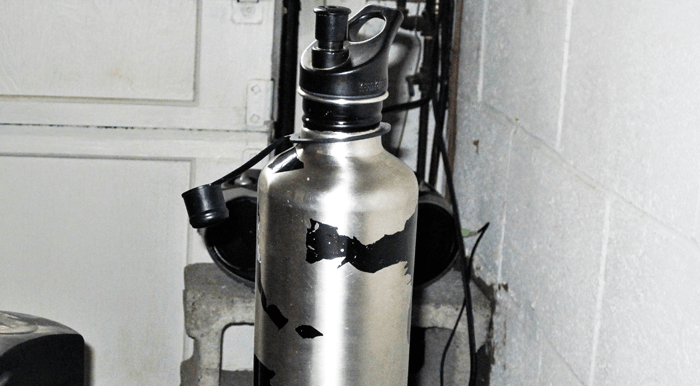
It’s a good water holder that isn’t made of plastic. I have three of these, and I love them.
The only downside is that they don’t take well to violence. All of mine have fallen seemingly the day after I got them. All are dented. The good news is that they all still function, and that’s good enough for me.
I like the sport top, myself. That’s the spout thingamagic that’s in the picture above.
#22, Things that sit in the corner, never to be used
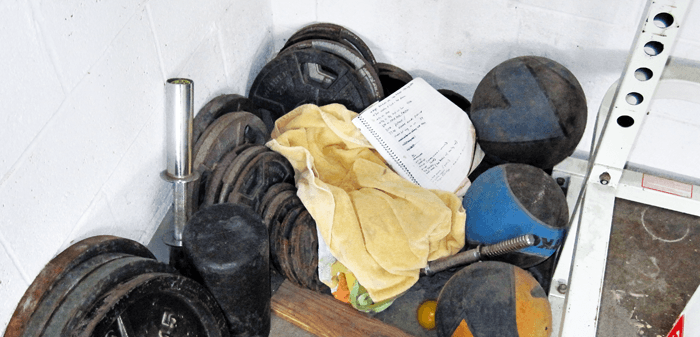
What kind of a garage would it be without them? Here you see standard plates, adjustable dumbbells, medicine balls, and a foam roller. Some other things are underneath of the junk, but I had ambition with all of these at some point.
Not anymore.
#23, Open field of grass
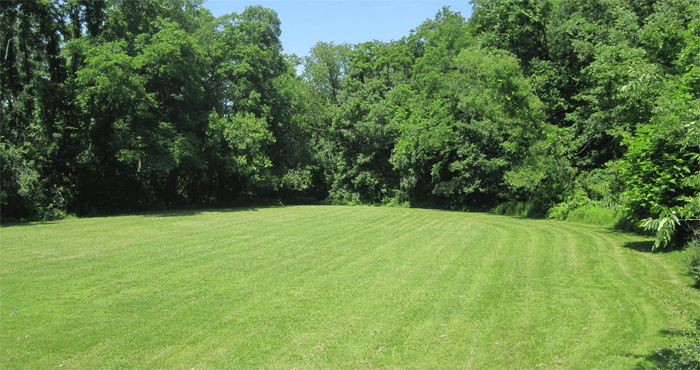
Blame my tricking roots, but I always have my eye open for a quality open field of grass. Bonus points if it’s secluded, as it’s not very enjoyable to have people gawk at you while you flip upside down.
AND NOW, IF YOU HAVE THE $$$ AND SPACE, HERE’S A CHECKLIST TO MOVE THROUGH
Ratchet one:
- Buy a good barbell.
- Buy plates.
- Do bodyweight stuff and deadlifts of all kinds. Conventional, high pulls, low pulls. Snatch pulls. Do some barbell rows. Some barbell curls.
- Dabble in power cleans to get the bar to your shoulders. Do front squats and overhead presses.
Ratchet two:
- Buy a good power rack, one that allows you to do squats, pull-ups, and dips.
- Add these to your programs.
Ratchet three:
- Buy an incline capable bench
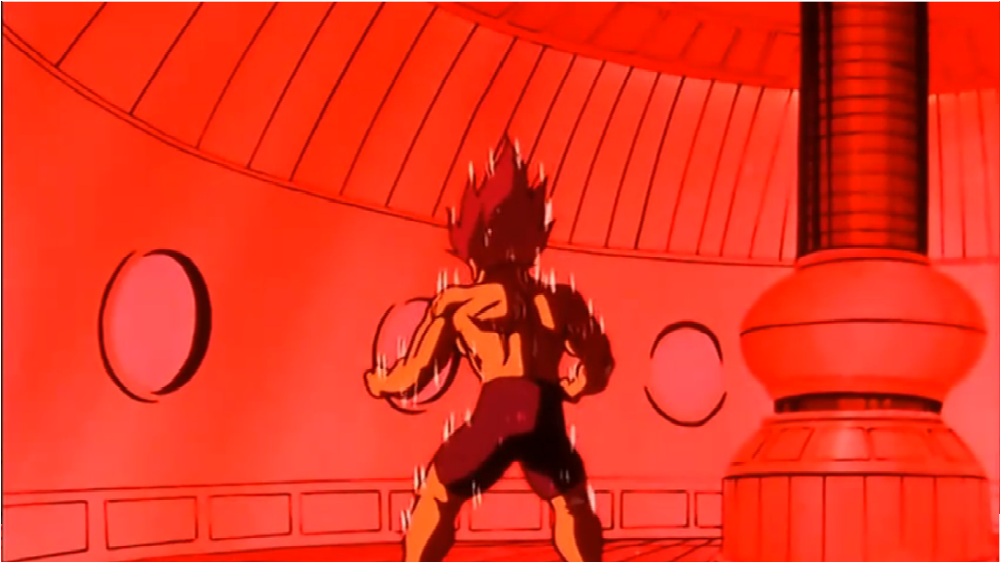
If you don’t mind going to the gym and having people watch you, then you might not need a home gym. If you don’t mind playing, “I need that piece of equipment but someone’s using it” roulette, or “I’m using this piece of equipment and someone is stalking me for it” roulette, then maybe you don’t need a garage gym either.
But, for me, having a shrine to train in within walking distance is convenient.
If you’re the type of person that’s ready to get after it, chances are you’re going benefit hugely from a home garage gym. Likewise, if you hate the public or crowds (introverts unite!), a home garage gym is another huge advantage.
Chalk one up (holy pun master) to those of us that’d rather listen to our own music as loud as we want, chalk up our hands like there’s no tomorrow, and generally not deal with society and crowded places.
